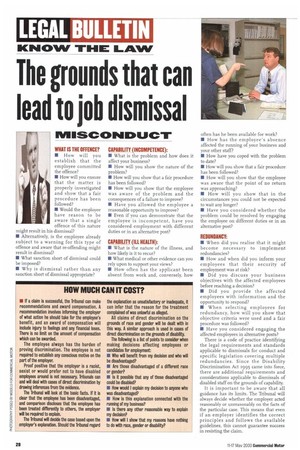The grounds that can lead to job dismissal
Page 30

If you've noticed an error in this article please click here to report it so we can fix it.
MISOCONCOUCT WHAT IS THE OFFENCE?
• How will you establish that the employee committed the offence?
• How will you ensure that the matter is properly investigated and show that a fair procedure has been followed?
• Would the employee have reason to be aware that a single offence of this nature might result in his dismissal?
• Alternatively, is the employee already subject to a warning for this type of offence and aware that re-offending might result in dismissal?
• What sanction short of dismissal could be imposed?
• Why is dismissal rather than any sanction short of dismissal appropriate? CAPABILITY (INCOMPETENCE): • What is the problem and how does it affect your business?
• How will you show the nature of the problem?
• How will you show that a fair procedure has been followed?
• How will you show that the employee was aware of the problem and the consequences of a failure to improve?
• Have you allowed the employee a reasonable opportunity to improve?
• Even if you can demonstrate that the employee is incompetent, have you considered employment with different duties or in an alternative post?
CAPABILITY (ILL HEALTH):
• What is the nature of the illness, and how likely is it to recur?
• What medical or other evidence can you rely upon to support your views?
• How often has the applicant been absent from work and, conversely, how often has he been available for work?
• How has the employee's absence affected the running of your business and your other staff?
• How have you coped with the problem to date?
• How will you show that a fair procedure has been followed?
• How will you show that the employee was aware that the point of no return was approaching?
• How will you show that in the circumstances you could not be expected to wait any longer?
• Have you considered whether the problem could be resolved by engaging the employee on different duties or in an alternative post?
REDUNDANCY: • When did you realise that it might become necessary to implement redundancies?
• How and when did you inform your employees that their security of employment was at risk?
• Did you discuss your business objectives with the affected employees before reaching a decision?
• Did you provide the affected employees with information and the opportunity to respond?
• When selecting employees for redundancy, how will you show that objective criteria were used and a fair procedure was followed?
• Have you considered engaging the affected employees in alternative posts?
There is a code of practice identifying the legal requirements and standards applicable to dismissals for conduct and specific legislation covering multiple redundancies. Since the Disability Discrimination Act 1995 came into force, there are additional requirements and considerations applicable to dismissals of disabled staff on the grounds of capability.
It is important to be aware that all guidance has its limits. The Tribunal will always decide whether the employer acted reasonably or unreasonably on the facts of the particular case. This means that even if an employer identifies the correct principles and follows the available guidelines, this cannot guarantee success in resisting the claim.




































































































